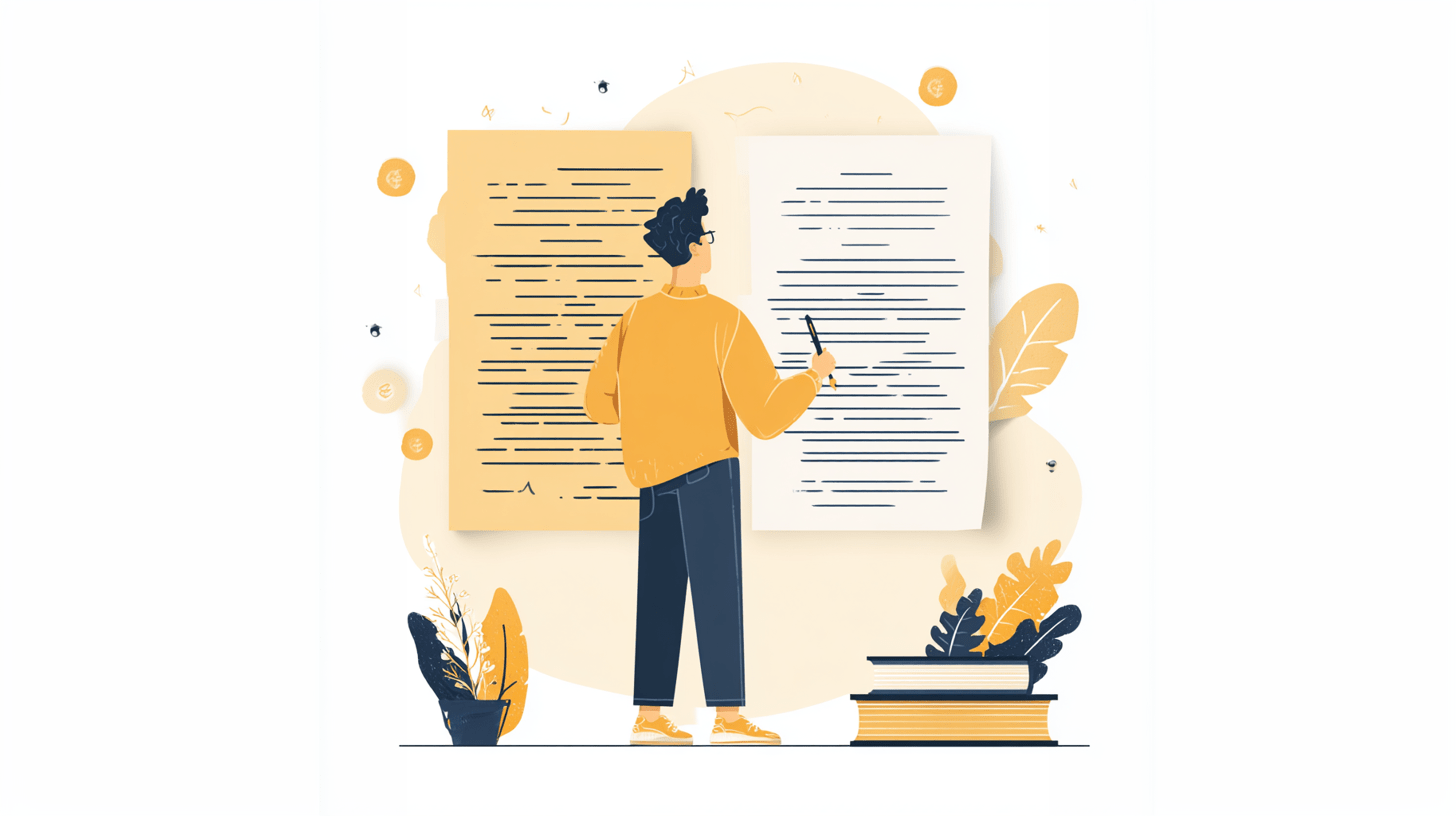Who doesn’t enjoy those rare moments where every word falls into place like puzzle pieces and you manage to create a perfect paragraph or even a whole paper? The natural desire that appears after you reread these written materials is to use them again for another project, as there’s nothing you can improve.
But will you have any problems after copying something you’ve previously written and pasting it into your new drafts? Can you plagiarize yourself?
Whether you like it or not, you’ve just entered the murky waters of self plagiarism, where the rules feel counterintuitive and the boundaries shift depending on whom you ask.
Self plagiarism exists in a gray zone between practical efficiency and ethical violation. It’s different from traditional plagiarism, where the intent to deceive is often clear, as it raises thorny questions about originality and reader expectations.
For instance, a freelancer repurposing blog posts in a book might receive positive feedback for entrepreneurial thinking, while an academic publishing the same data in two journals could face career-damaging consequences.
When you get a positive answer to the question: “Is it plagiarism to use your own work?”, it may seem illogical and even absurd. Therefore, let’s dive into what self-plagiarism actually means and how to reuse your own work without crossing ethical lines.
What Is Self Plagiarism?
To answer this question and understand this concept, we must move past the common understanding of plagiarism as theft from another source. At its core, the self plagiarism definition refers to the practice of reusing your own previously published work without proper acknowledgment or disclosure. You might have also heard similar terms like text recycling, duplicate publication, or redundant publication, depending on the context.
Types of self-plagiarism you should be aware of
To get a better understanding of the self plagiarism meaning, let’s consider its several distinct types.
Duplicate publication
This is an unpleasant situation when you submit the same work to multiple venues simultaneously without informing editors or readers. It is perhaps the most clear-cut form of self-plagiarism and is not ethically correct in academic and journalistic contexts.
Salami slicing
Suppose you have one comprehensive piece of your work and want to divide it into multiple smaller publications. Will it lead to negative consequences? Most probably, it will, because this practice is particularly problematic in academic settings and artificially inflates publication counts. Doing so can misrepresent the scope and significance of your research findings.
Text recycling
Simply put, this is when you reuse sentences, paragraphs, or longer passages from your own previous publications without citing the original. This is the most common form of self-plagiarism and can range from an acceptable standard practice to a serious ethical violation depending on the circumstances.
Copyright infringement of your own work
In this unique situation, you’ve transferred copyright to a publisher and no longer have the legal right to reuse your own words, even though you wrote them.
The Difference Between Self-Citation and Self-Plagiarism
It is also crucial to draw a clear line between reusing text and citing your prior work. Self-citation is ethical and often necessary, as it establishes the foundation for your current research. Self-plagiarism occurs when you copy and paste sentences or paragraphs without quotation marks and a citation, as it’s misleading for the reader who believes that the text is unique.
Why does any of this matter?
So what? Yes, you’re using a text you’ve published before, but what’s wrong with that? It’s not like you stole someone else’s ideas, and you regularly use a plagiarism check tool, right? Well, there still might be some ethical concerns.
- The issue of novelty. In many fields, particularly academia and high-level journalism, originality determines the value of a submission. When you submit work, you make others think that the ideas and writing are new. Consequently, if you reuse substantial portions of old text, you are seeking credit for work you have already received credit for. This is often why the question, “Is it possible to plagiarize yourself?”, is answered with affirmation by institutional policy.
- The issue of copyright. It is the legal consideration that many people often overlook. When a journal or publisher accepts your manuscript, you typically transfer the copyright of that work to them. Once the publisher owns the rights, reusing large chunks of that text in a new manuscript is technically a violation of their copyright, not just an ethical lapse.
The Contexts That Define the Rules
The murky waters of self-plagiarism are particularly confusing because the rules change depending on the context. What’s considered unethical duplicate publication in one field might be a perfectly acceptable practice in another. The question isn’t just about what you’re doing, but where, why, and for whom.
Academic environments
In university settings, the standards are incredibly strict. You will violate academic honesty if you use a paper from an old course for a new one or reuse a literature review from a master’s thesis in a doctoral dissertation. The core principle is that every assignment must demonstrate how well you’ve understood the new material specific to the course or degree. If you wonder, “Is it possible to grade my essay according to these criteria before submitting it?”, the answer is “Yes.” Simply use our tool to meet your writing goals.
Journalistic settings
A reporter covering an ongoing story might include similar background information in multiple articles, and this isn’t considered self plagiarism. However, a freelancer submitting the same feature article to two competing magazines without disclosure violates professional ethics. The key difference is in the reader’s expectation and the editorial agreement.
Bloggers and content creators
Updating and republishing an evergreen blog post with fresh information is more about content maintenance than self-plagiarism. Moreover, cross-posting the same content to Medium and your personal blog is common practice, though SEO considerations might make it a bad idea. Search engines penalize duplicate content; therefore, if you publish the same text in multiple places, you might actually harm your visibility rather than expand it.
Hybrid situations
The murkiness increases when you consider ambiguous situations.
- What about turning the interview quotes you gave to one publication into content for your own blog?
- What about using the same research to write both a technical white paper and a popular press article?
- What about updating your dissertation chapters for journal publication?
In each case, the answer depends on disclosure, substantial reworking, and whether you’re meeting reasonable expectations for originality.
The Ethics of Data and Visual Reuse
We’ve considered the recommendations about reusing content you’ve previously created in general and can move on to a more specific question. Can you reuse non-textual elements, such as figures, tables, graphs, and underlying data, without violating any ethical rules? You’ll find all the answers in the table below.
Non-textual elements | Ethical rule | What you need to do |
Figures and tables | These are copyrighted images, so when you transfer copyright of an article to a publisher, you transfer the rights to the visuals as well. | Get written permission from the copyright holder and include a reprint line with full citation. |
Raw data | You are generally free to reuse your own raw data (measurements, survey responses, etc.) if your new paper offers a novel analysis or interpretation of that data. | Re-report the facts, but ensure you entirely rewrite and reframe the new analysis. |
Explaining data/Methods | When you explain how you collected the data or summarize initial findings, it is subject to standard self-plagiarism rules. | Rewrite the text completely. If the description is essential, place the extract in quotation marks and provide a full self-citation. |
When is it Acceptable to Reuse Your Writing?
As we’ve reviewed the negative consequences of self-plagiarism, you might wonder whether there are cases when it’s acceptable to reuse your own work. And yes, there are exceptions to the strict rules of the self plagiarism definition.
Permissible self-citation
Whenever your previous research forms the logical basis for your current work, citing yourself is a standard academic practice. For instance, citing the definitions or initial findings from a 2021 paper to support the advanced analysis in a 2025 paper is perfectly acceptable. The key is to cite instead of copying. However, if you don’t want to cite your earlier work and are looking for some fresh ideas, you can use our college essay topic generator whenever you get stuck while brainstorming.
Institutional guidelines and publisher policy
Some academic institutions may have specific guidelines that allow for limited reuse. For example, some universities permit doctoral candidates to reuse chapters from a previously published master’s thesis after they receive signed permission. That’s why it’s crucial for you to always get this written permission and submit it with your assignment.
Permission granted
Suppose you published an article and transferred copyright. In that case, you can contact the publisher’s permissions department and request the right to reuse a specific table or paragraph of text in your new publication. Note that if they grant written permission, you must include the required attribution line.
Intellectual development of your previous ideas
Understanding the distinction between building on your own ideas and copy-pasting is also important. Every time you return to the themes and arguments you’ve developed earlier and add fresh angles to these topics, you will not be accused of self-plagiarism. That means using those arguments as a basis for a deeper analysis that brings even more value to the readers.
The Ultimate Checklist for Writers to Avoid Self-Plagiarism
This article would not be as useful as it is without actionable guidelines to help you reuse your work ethically. Use these practical strategies and tailor them according to your specific writing context.
#1 Always check the publisher’s or journal’s policies first
This is your most important step. If you don’t fully understand a policy, ask directly and don’t assume. Running your work through plagiarism and AI checker tools before submission can help you identify potential overlaps you might have forgotten.
#2 Rely on disclosure as your best friend
When submitting a new paper to an editor or professor, always include a note in your cover letter where you bring out any potential overlap. Transparency rarely hurts you, but discovering duplicate publication almost always does.
#3 Keep detailed records of what you’ve published
We tend to forget things over time, so make sure you note down what you’ve written and where it appeared. Maintain a spreadsheet tracking your publications, including dates, outlets, rights sold, and key themes.
#4 Rewrite instead of paraphrasing your text
When you want to reuse a paragraph, avoid reading the original document and write the section completely from scratch, focusing on the new paper’s context. Then, you will end up having an original piece instead of looking for synonyms and paraphrasing techniques. Remember that if you’re struggling to say something differently, consider whether you’re adding a sufficient amount of new value to justify the new piece.
#5 Use plagiarism checkers before submission
Before submitting an article or paper, run it through plagiarism checkers that will flag overlaps with your previous publications. Many universities and publishers use these tools, so you can catch problems early. A trustworthy grammar checker can also help you polish sentences to make them different from previous versions.
#6 Use the rule of novelty
This point is a continuation of the previous idea. Before writing, ask yourself: “What is the new contribution of this piece? If I reuse this older text, does it undermine the novelty of this new submission?” If the answer is yes, you must rewrite it.
#7 Create canonical versions and variations
Use this smart strategy whenever you need to address similar topics for different audiences. You should do the following.
- Establish one comprehensive “home base” version of your thinking on a topic.
- Create variations for different contexts (for example, a simplified version for general audiences, a technical version for specialists, etc.).
- Make sure you customize each variation according to its audience and purpose.
#8 Treat your work and your audience with respect
Apart from the legal issues, ethical reuse is also about respect. Whether you are a writer or blogger, respect your readers, who deserve unique value for their time and money. On top of that, you should respect editors and publishers, who invest in your work. Most importantly, respect yourself as a professional whose reputation depends on your integrity.





